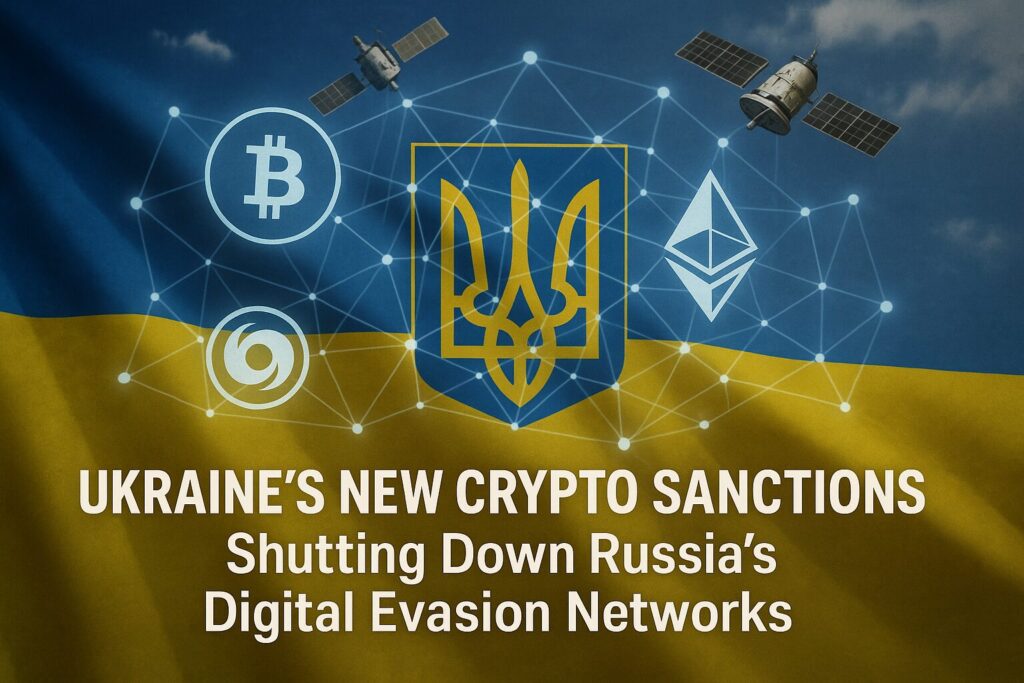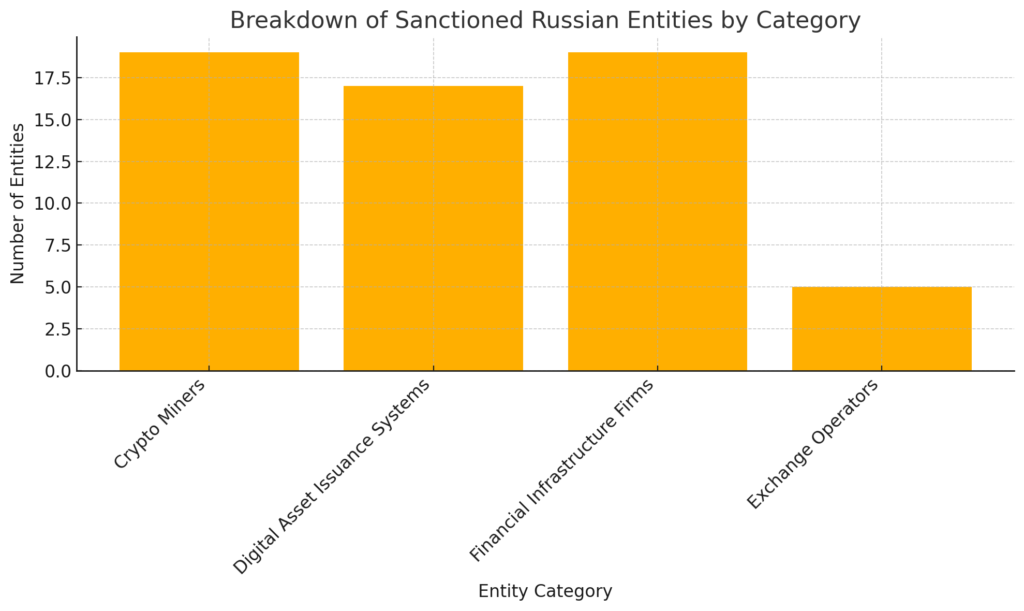
Main Points:
- On July 6, 2025, President Volodymyr Zelenskyy signed a decree imposing sanctions on 60 companies and 73 individuals involved in Russia’s crypto-based sanctions evasion.
- Sanctions freeze all designated entities’ assets in Ukraine and ban their domestic economic activity.
- Affected Russian entities include 19 crypto miners, 17 digital-asset issuance platforms, 19 financial infrastructure firms, and 5 exchange operators (Figure 1).
- Sanctions extend to foreign enablers in Cyprus, Kazakhstan, and the UAE—some already under U.S. restrictions.
- The move highlights how Russia increasingly relies on digital assets to fund its military-industrial complex amid traditional channel blockades.
- Recent trends: Rising adoption of mixing services and stablecoins to mask fund flows; ongoing U.S. measures against Tornado Cash; Europe’s parallel sanction efforts.
1. Background: Crypto’s Role in War Financing
Since the full-scale invasion of Ukraine in February 2022, Russia has faced sweeping financial sanctions from Western governments. As those measures tightened, Moscow turned to cryptocurrencies and other digital assets to move capital beyond reach. Estimates suggest that crypto-based transfers worth $10 billion or more have flowed to entities linked to Russia’s military-industrial complex between 2022 and mid-2025.
Traditional banking and SWIFT rails have been largely cut off; in response, Russian actors have adopted peer-to-peer trading, stablecoin transactions, and decentralized finance (DeFi) protocols to circumvent restrictions. Crypto can be moved almost anonymously, quickly, and across borders, making it an attractive channel for sanctions evasion.
2. Scope of Ukraine’s Sanctions
On July 6, 2025, President Zelenskyy formalized a sanctions package targeting both 60 entities and 73 individuals accused of enabling Russia’s digital evasion schemes. The measures:
- Asset Freeze: All Ukrainian-based assets of the listed companies and persons are frozen immediately.
- Activity Ban: Designated entities are prohibited from conducting any business within Ukrainian territory.
- Crypto Miners (19): Including members of Russia’s Industrial Mining Association accused of structuring mining operations to repatriate proceeds off-book.
- Digital Asset Issuance Platforms (17): Firms operating systems for issuing tokens and other digital financial assets—some already blacklisted by the U.S. Treasury.
- Financial Infrastructure Firms (19): Manufacturers of payment terminals, international transaction intermediaries, and other crypto-adjacent service providers.
- Exchange Operators (5): Domestic and offshore trading platforms that facilitate large-volume crypto movements.
Figure 1 shows the categorical breakdown of sanctioned Russian entities.

3. Inclusion of Foreign Enablers
Ukraine’s decree also named several non-Russian companies accused of facilitating the evasion schemes:
- Cyprus: TOKENTRUST HOLDINGS LIMITED.
- Kazakhstan: EXMO RBC LTD.
- UAE: Three firms linked to payment and settlement services.
Some of these foreign entities were already subject to U.S. sanctions, underscoring international coordination in targeting crypto-based money laundering. President Zelenskyy noted that Ukraine’s actions complement allied measures and represent Kyiv’s determination to “shut down all such schemes” domestically.
4. Impact on Russia’s War Effort
Analysts estimate that the sanctioned networks have facilitated tens of billions of dollars in crypto inflows since early 2025, much of which allegedly supported Russia’s defense and industrial operations. By dismantling these channels, Ukraine aims to:
- Deprive Moscow of alternative funding sources.
- Deter service providers from enabling illicit flows.
- Signal to global partners its commitment to enforcing comprehensive sanctions.
5. Recent Trends in Crypto Evasion
Beyond Ukraine’s sanctions, several developments illustrate how digital-asset flows continue to evolve:
- Mixing Services Surge: Use of anonymizing mixers—such as Tornado Cash, sanctioned by the U.S. in 2023—remains high, with on-chain analytics showing a 30% uptick in mixed volumes year-on-year.
- Stablecoin Adoption: USDT and USDC volumes involving Russian wallets have grown by over 40% since 2024, offering rapid onboarding and minimal volatility.
- DeFi Bridges: Cross-chain bridges (e.g., Wormhole, Axelar) are increasingly used for cross-border swaps, though recent exploits have drawn regulatory scrutiny.
- Global Sanction Efforts: The EU recently announced parallel measures to target crypto mixers and NFT marketplaces linked to illicit funding.
6. Challenges and Next Steps
While sanctioning these networks deals a blow, enforcement remains challenging:
- Pseudonymity: Blockchain addresses are not tied to real-world identities without extensive on-chain forensics.
- Jurisdictional Limits: Ukrainian measures apply only within its jurisdiction; truly global enforcement relies on coordination with the U.S., EU, and others.
- Evolving Technology: New privacy-focused chains (e.g., Monero, Zcash) and Layer 2 solutions complicate tracking.
Looking ahead, suggested strategies include:
- Enhanced Analytics: Investing in AI-driven blockchain forensics to unmask obfuscated flows.
- Cross-Border Cooperation: Harmonizing sanction lists and sharing intelligence among allied states.
- Regulatory Innovation: Extending licensing requirements to services offering crypto-OTC trading or DeFi ramp-on/off ramps.
Conclusion
Ukraine’s July 6 sanctions represent a robust step in countering Russia’s pivot to cryptocurrencies for sanctions evasion. By freezing assets and banning domestic operations of key service providers—ranging from miners to exchange operators—Kyiv disrupts vital nodes in Moscow’s digital finance networks. However, as the cat-and-mouse game continues, broader international alignment, advanced forensic capabilities, and adaptive regulatory frameworks will be essential to stem illicit flows and uphold the integrity of global financial sanctions.

